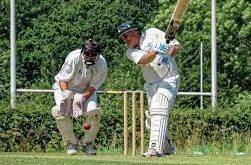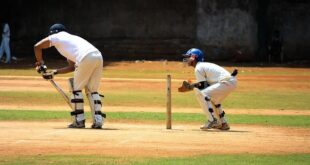Originating in southeast England, cricket became a national sport in England in the 18th century. Today cricket is one of the most popular games in the UK and abroad.
In Cricket, bowling is the action of throwing the ball toward the wicket guarded by a batsman. A cricket bowling machine is a device made specifically for the batsmen of cricket to practice. It repeatedly throws the ball at the batsman allowing them to experience different techniques. The purpose of this machine is to simulate the function of the bowler in the sport of cricket and is meant to support the batsmen to develop their batting skills. The machine can generate different patterns of bowling.
There are a number of different types of bowling machines available to cricket coaches and most allow the use of remote control so that a coach can be closer to a batsman when the stroke is played. Following are the main types of bowling machines available. One is mechanical and the other is Pneumatic. A bowling machine is an essential part of every team and cricket club and it will be of much use at school, club and junior levels where the standards of bowling are less consistent
Table of Contents
Different delivery techniques:
- Swing bowling
Swing bowling is a bowling technique used in cricket as to where a new but slightly worn ball is used. The aim of swing bowling is to cause the ball to move in the air causing it to swing. The purpose of swing bowling is to get the cricket ball to deviate sideways as it moves through the air towards or away from the batsman. To do so, the bowler has to use a polishing liquid or lubricate one side of the ball. This, with time, causes the other side of the ball which unpolished to deteriorate causing the ball to swing. To simulate this using a bowling machine, keep the plane of the wheels flat and the motors to run at slightly different speeds. This will cause the ball to spin about an axis perpendicular to the ground. If you slow down the wheel on one side the ball will swing in that direction.
- Fast bowling
Also called pace bowling and as the name suggests, a fast bowler in cricket relies on speed. Most pace bowlers are medium-fast to fast in top level cricket. In general, bowlers of this type are described as right arm or left arm “fast” or “fast-medium”. Typically, younger pace bowlers tend to rely exclusively on speed. To simulate a fast-bowling technique on the bowling machine, both wheels must set on the same speed as fast as the person being trained could handle. The machine could be moved around slightly to vary the line and length of each ball.
- Seam bowling
Seam bowling is classed as a subtype to fast bowling. Seam bowling is yet another bowling technique where the ball is bowled onto its seam causing a random deviation to the ball. This happens due to the cricket ball being not a perfect sphere. The seam of the ball is a circular stitch that joins the two halves of the cricket ball. The seam joining two pieces of leather so the stitching of the seam is noticeably raised. If the ball is bowled in a way that the seam hits the pitch when it bounces, this irregularity causes the ball to deviate sideways in its path. It could move in any possible direction even straightforward and the batsman has to figure out how the ball would move and in which direction to make his shot. Hitting the seam is not as easy as it sounds though. The seam has to be held upright position between the index finger and the middle finger at the time of the delivery and, most importantly, the wrist has to be straight when the ball is delivered. The tedious and precise technique of achieving a seam bowling makes it impossible to replicate on a bowling machine though.
- Spin bowling
In spin bowling the speed of the ball is not crucial. The main aim here is to bowl the cricket ball with rapid rotation so that when it bounces on the pitch it will deviate from its normal straight path subsequently making it harder for the batsman to predict and hit the ball accurately. A spin bowler usually uses either predominant wrist or finger motion to impart spin to the ball around a horizontal axis at an oblique angle to the pitch. This causes the ball to deviate sideways through the air before it bounces off due to some physical properties. This deviation of the ball is also called drift. The combination of drift and spin can make the ball’s trajectory complex, with a change of direction at the bounce. Spin bowlers are generally given the task of bowling with an old, worn cricket ball. A new cricket ball better suits the technique of fast bowling rather than spin bowling. When it comes to the bowling machine, the machine should be tilted to one side, and the wheels set to different speeds as per swing bowling. It’s also necessary to make the machine bowl slower than usual.
- Bouncer
In cricket, a bouncer is a type of short pitched delivery. It bounces once and usually reaches the batsman at head level and it’s used to drive the batsman back on to his back foot if he has been freely playing front foot scoring shots. To simulate a bouncer shot, the same mechanism used for swing bowling is used in bouncer, by pointing the curve of the tubing somewhere between the vertical and horizontal axis.
Types of bowling machines:
As previously mentioned, there are two types of bowling machines one is mechanical and the other pneumatic. Mechanical bowling machines are the most common type because it’s simple and reliable. Here’s how it works:
The main mechanism of the machine consists of two heavy wheels, each driven by its own electric motor. These are mounted in a frame so that the wheels are in the same. A ball joint allows the machine a wide range of movement. The whole assembly is mounted on a sturdy tripod or other frame so that the plane of the wheels is roughly at the height that a typical bowler would release the ball. The motors are typically powered by a car battery, and turn in opposite directions. A controller allows variation of the speed of each wheel, allowing the machine to be slowed down for less experienced batsmen, or when the motors are not running at the same speed, swing or spin bowling can be simulated. These machines will work with any ball of roughly the right size and weight, such as normal cricket balls or tennis balls. However, they usually work best with their own balls, bowling machine balls which are made of hard plastic, and are covered in dimples.
The other type of bowling machines being pneumatic. Their design is significantly less common than their mechanical counterpart and less used. Here’s how they operate:
The space that takes the most space in the machine and engulfs the cricket balls is called the hopper. Near the hopper there is a rotor which usually has space for six balls. The balls slot into their place due to gravity and their own weight. A pump provides flow of air in the chamber where the ball drops. The air pushes the ball along the chamber to the restrictor. The restrictor has a hole through it that is slightly smaller than the ball, which the ball presses up against. This seals the hole, so air pressure builds up in the chamber. When the pressure builds up that the restrictor can no longer hold it ball bursts out of the main body of the machine and into an external tube, which guides it upwards and releases it at the height of a bowler’s arm
Both types of bowling machines, however, can simulate the same types of bowling techniques mentioned previously.
Programmable bowling machines:
Both mechanical and pneumatic types of bowling machines are of very simple designs to handle regular and hard use by cricket clubs making them simple to operate and reliable. Those types however can only simulate one type of technique through the given configuration set by the operator. This can be very limiting and useless to players of professional and higher rankings in cricket. Programmable bowling machines were designed to improve these limitations by constantly re-configuring themselves to bowl different types of delivery in quick successions. One of the most notable programmable bowling machines is called “Merlyn” with claims by its makers that it could “bowl any ball known to man”. This machine has significant elements of computer control that is built in and can reproduce any delivery if the correct data is used. Although its exact mechanism has not been revealed it is safe to assume it is much more complex than the other machines. One of the best aspects to the machine is that it provides no indication of the type of ball it is about to bowl until the ball has left the machine. This makes batsmen work on their instinctive batting, rather than trying to second guess the bowler. You will be able to react to a bowler’s placement without even thinking about it.
How a Bowling Machine Can Improve Your Batting Skills:
- Consistency:
A bowling machine gives you the option to repeatedly throw the ball as many times as you’d like. This helps build consistency and with consistency comes muscle memory and subsequently, you would be able to react to a bowler’s placement without even thinking about it. This gives you the opportunity to focus on other aspects of the game like field placements and because overtraining batsmen could be a risk a bowling machines helps coaches combat problem areas and for them to be worked out without causing bowlers to overdo themselves.
- Footwork
New players of cricket might not know but footwork is one of the most important aspects of a good batsman. Short pitched balls are especially hard for bowlers to achieve so being able to set the machine for accurate short pitched balls allows for easy practice of back foot play.
- Advancements in bowling machines
Bowling machines have advanced exponentially in recent years. Long gone are the days of single speed tee-up machines. Newer models of bowling machines can replicate almost any bowling style from changes in line and length, to spin and swing. These adjustments also mean that a single machine can be used for players of all levels. As you advance through the game you can always stay one step ahead of your competition. Nothing puts a batsman at ease than having all the time in the world to play their shots.
How to maintain a bowling machine:
A crucial part to making a cricket bowling machine operate smoothly and keep it from running into problems is maintaining it. A cricket bowling machine is very easily maintained and doesn’t require much maintenance. A few instructions, however, are recommended. Avoid accidental starting when reconnecting to a power supply. The machine should always be turned off when connecting the power supply. Do not allow the bowling machine to fall on its wheels. This could result in non-warrantied damage. Always check the tightness of bolts and screws especially before operating the machine. If any loose screws or bolts are noticed or you hear a rattling noise the screws and bolts should be tightened before further use. Keep the machine clean, and free of grit and dirt especially the tires and never use liquids such as brake fluid, gasoline, petroleum-based products, or any solvents to clean the machine.
Best Cricket Bowling Machines UK
Now that you have read all about cricket bowling machines, here are our recommendations for new bowling machines.
This bowling machine offers realistic bowling simulation with speeds reaching up to 55 mph and a swing delivery function. Also, this machine offers multiple buying options. You could purchase the machine on its own, machine with 12PK balls, machine with 12PK balls and battery kit, machine with battery kit or battery kit only. This bowling machine allows the user to adjust the speed and has a 12-ball capacity with an auto-ball feeder. Only paceman balls should be used with this machine though. This cricket bowling machine is suitable for any place including clubs, schools or at home. With the Paceman Classic you can get the most out of your batting practice and put in the extra hours in the garden as well as down the local club because it’s portable, light and simple to store.
Features:
- Bowling machine allows users to alter ball speeds, swing characteristics & ball length.
- Will deliver cricket balls of speeds up to 55mph (90kph).
- 12 ball capacity auto-ball feeder included for solo batting practice.
- 1x Paceman Cricket Ball included as standard.
- Bowling Machine features an integrated 3G Paceman Drive System.
- POWER SOURCE:
- UK mains powered (220-240v) – comes with standard 3-pin plug.
- Other countries may require a voltage converter for optimal performance.
Features:
- Allows players & coaches to adjust the delivery length, swing, speed & spin
- Will deliver at speeds up to 68mph (110kph) with a Paceman Original Light Ball
- Will deliver at speeds up to 56mph (90kph) with a Paceman Regular Ball
- 1x Regular Paceman Bowling Machine Ball included as standard
- Maintenance-free Concave moulded TPR wheel
- Mains Powered (220-240V) & comes with a UK regulation 3-pin plug
- Optional Battery Kit: 1000W pure sine waver inverter with 12V deep cycle lead-acid battery (2-hour battery life) – CHARGER NOT INCLUDED
- 12-ball capacity auto-feeder included as standard
- Optional 12 Pack of Regular Paceman Balls available
Features:
- Provides accurate feeds for hours allowing you to perfect different shots
- Battery-powered so can be used anywhere (4 x D batteries)
- Used with tennis balls or Feed Buddy balls
- Appropriate for any age or ability to groove shots over and over again alone
- Comes with ball feeder so you can stack 10 balls firing out every 5/6 seconds
- Gentle feed that travels 3-4m every time and is very accurate
- 4 settings for closer or longer feed
This Joe Root R66T is extremely portable. It works both on a battery and a power cord. It operates with 4 x D Batteries and the UK power plug is included when you purchase the machine. It releases a ball every 8 seconds and it is endorsed by England Captain Joe Root and Glamorgan Cricketer Billy Root making it a perfect and reliable training aid for professional cricket players.
 UniSportOnline The world of everything sport
UniSportOnline The world of everything sport




![Paceman Bowling Machine [Pro X2] – Cricket Bowling Machine for Cricket Clubs | Professional Cricket Ball Machine with Spin Adjustment | Cricket Training Equipment (Bowling Machine + Feeder + Balls)](https://m.media-amazon.com/images/I/31mMXfxI+zS._SL160_.jpg)


